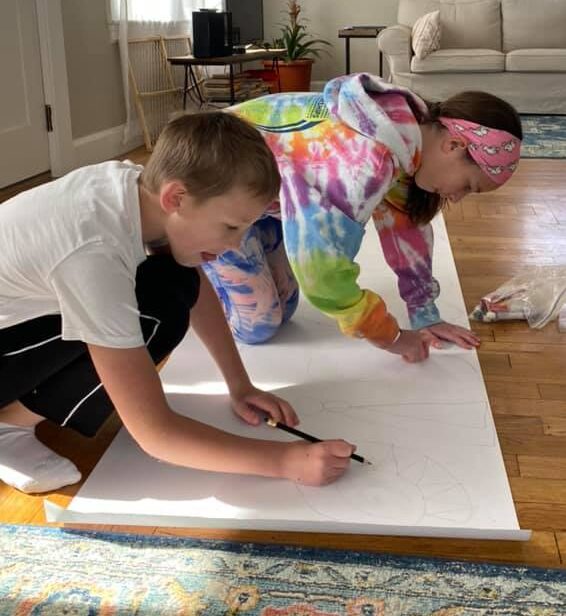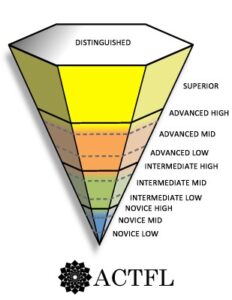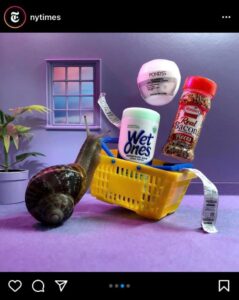
Lesson planning can often seem daunting and overwhelming, and there are some tips to help us know how best to serve our students. In order to most effectively create lessons, we want to think about our students needs, their language markers and language growth. In language, we work with the ACTFL Proficiency Guidelines, which show us how we acquire language and provide road markers to let us know how we are growing in the language. Below you can see how the levels move from Novice to Distinguished, and how within the levels there are sub levels. We want to praise students where they are and constantly be gently ‘pushing’ them towards the next level. We do this through our questioning in class.

Within questioning, there are Novice, Intermediate and Advanced prompts. (There are Superior and Distinguished as well, however, most K-12 and even K-16 teachers and professors tend to fit within the Novice to Advanced prompt range. For our purposes today, we will focus more on these prompts.)
Novice prompts are close-ended, while Intermediate and Advanced prompts are open-ended, with Advanced prompts asking for time frames, and more detail. You utilize the varied prompt levels at the necessary moments.
Novice Low – novice prompts
Novice Mid – novice prompts, and beginning to introduce some intermediate prompts
Novice High – mostly intermediate prompts, with some scaffolding of novice prompts
Intermediate Low – intermediate prompts
Intermediate Mid – intermediate prompts, and beginning to introduce some advanced prompts
Intermediate High – advanced prompts, with some scaffolding of intermediate, possibly even novice prompts for warm up.
The pattern continues with Advanced Low-High. This is a rough guideline for beginning to understand when and how to use prompts. As you begin to recognize students language levels more and practice when and how to use which prompts, this will come more naturally. What has been introduced here is just the tip of the iceberg. We encourage you to 1. find out more about the ACTFL levels and their descriptions and characteristics 2. join our sessions and collaborate with other teachers 3. take a look at our Shop where we have a brand new Question Starter Card packet that shows you step by step how to create your own questions and includes at-a-glance cards for you to use in class!
In order to share some examples, here are some sequences from our OWL Facebook group, OWL Collaborative. There you can find samples of different prompts that the community has created together. Just ask to be accepted! The below sequence was pulled from a post by Jaclyn Hathaway-Rube on March 3. Take a moment to see the prompts at different levels and see how you can begin to use them with your students in class. Notice the variety of topics pulled from simple pictures.


Novice:
What do you see?
What is the snail doing?
List what is the same or different in the pictures.
Make a list of things you buy in the store.
What can you buy in the store with $50?
Do you go shopping? When?
What’s your favorite item to shop for? What’s the craziest thing you buy when shopping while hungry?
Do you like to ride on the grocery cart? Who pushes the cart?
Who does the groceries in your household? Do you help with the groceries?
Which snail is single and which one is married? Imagine your self as the single/married snail: create a list of what would be in your cart. Do any of the snails have kids? Which one cares most about the cleaning vs cooking?
What do you think the snail is going to make with the ingredients in the cart?
Do you like snails? (elevate to Intermediate with why or why not?)
When do you get chores done? Create a list of chores. List which chores make you feel like a snail.
Are you more creative during the day or night? (To elevate: Why?)
Intermediate:
A snail shopping brings up a lot of questions! What questions do you have?
Explain how you can use the items in the snails cart.
Create an ad/commercial for one of the products.
What questions do you have about the product after seeing your classmate’s ads?
Find out from the snail if Pond’s cream is a good cream to buy.
Describe the benefits of face creams. Do you use them? Why or why not? What do face cream ads tell us about aging and beauty?
Tell us about when you go shopping, do you use a basket or a cart? Why?
What do you think about how they price out organic food?
Describe the benefits of organic foods.
Describe where your foods come from. Explain how far it travels to be in your house.
When you buy, do you look at the price or the quality? Why? *Pros and con lists for novice, descriptions for intermediate, then gallery walk everyone’s lists or descriptions. Students debate the benefits of price or quality.
Describe the craziest things you buy when shopping while hungry, and explain how your mood affects your buying habits.
Make a meal with the items in the cart! Write the steps and describe how it tastes and/or tell me the steps to make what the snail is making.
Tell us about new foods you discovered in the last year. Have you started cooking? Why or why not?
Teach us a new recipe.
Pick one of the pictures and create the scene that you imagine is happening. Add dialog and lots of questions!
Night owl vs. Morning monkey(or snail in this instance). Compare the differences.
Tell a story about something unexpected that happened the last time you were grocery shopping. (maybe you saw some snails shopping in the same shop?).
In groups, recreate the unexpected event.
How have your shopping habits changed in the last year?
Tell me a story about a time that you felt like a snail in a store.
How have your eating habits changed in the last year? ( this might a little sensitive because of weight issues but it could lead to an interesting discussion about healthy habits, and exercise etc
Explain how shopping has changed in the last year. Share examples and societal implications. What has influenced this shift, or explain why there hasn’t been a shift.
Tell me about a time when you went shopping and the cart was full to overflowing. Elaborate with all the fun details!!
Describe detail how you buy: bulk or other ways? Explain in detail, with examples, the sustainability of our shopping system. Compare or contrast how Americans shop with other countries and what you notice about their shopping habits, if there is a need to overbuy, etc. What does that say about our different cultures and societies?
Explain to us how your chores are during the pandemic compared to how they were before. What has stayed the same or changed? Explain why.
